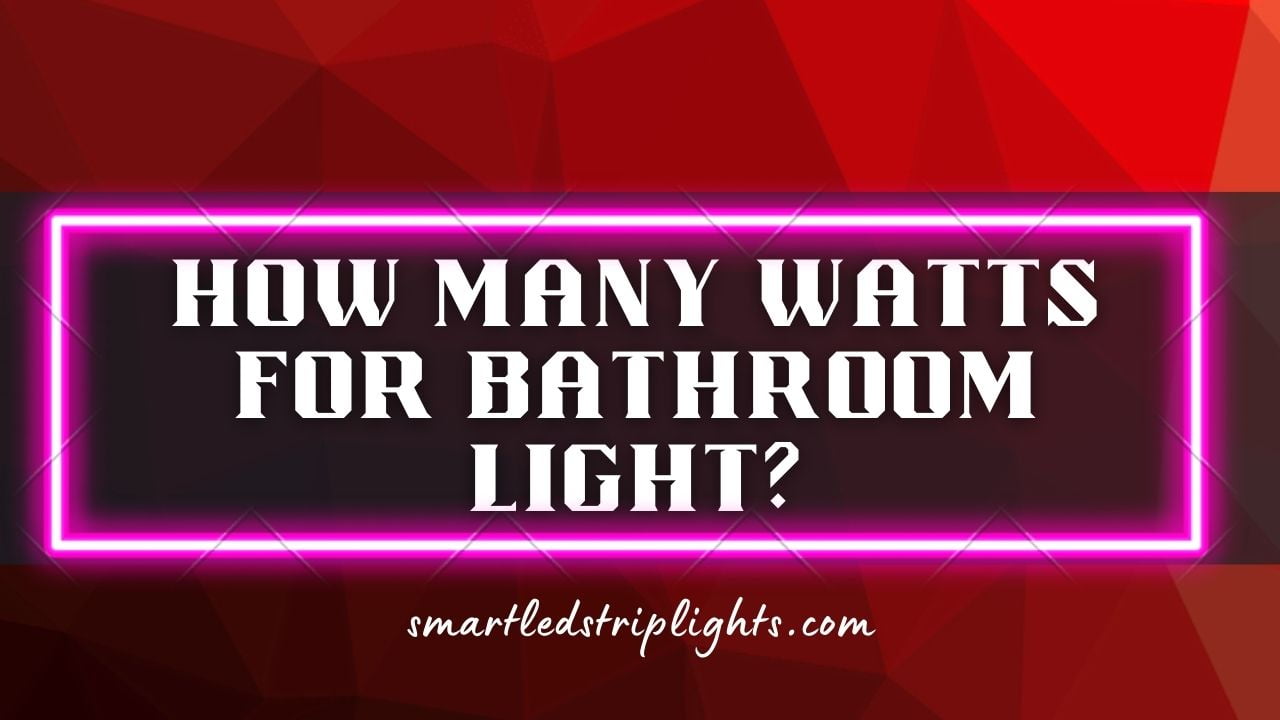Lumens and Wattage for Bathroom Lighting

Best wattage for bathroom lights – In the realm of bathroom illumination, understanding the interplay between lumens and wattage is crucial for achieving optimal brightness and ambiance. Lumens, measured in units called lumens (lm), quantify the total amount of visible light emitted by a light source, while wattage, measured in watts (W), indicates the electrical power consumed by the light source.
The relationship between lumens and wattage varies depending on the type of light source. Incandescent bulbs, for instance, produce fewer lumens per watt compared to LED bulbs, meaning they require higher wattage to achieve the same level of brightness. Fluorescent bulbs, on the other hand, offer high lumen output with relatively low wattage, making them an energy-efficient choice.
Types of Bathroom Lights
Different types of bathroom lights have varying lumen and wattage requirements. Incandescent bulbs, with their warm, traditional glow, typically require higher wattage (60-100W) to produce sufficient lumens (800-1600lm). LED bulbs, known for their energy efficiency and long lifespan, provide comparable lumen output with significantly lower wattage (8-15W). Fluorescent bulbs, characterized by their cool, even light, offer high lumen output (1000-2000lm) with low wattage (13-20W).
When designing your bathroom’s ambiance, lighting plays a crucial role. For optimal functionality, choose bulbs with a wattage suitable for the room’s size and layout. If you seek a touch of retro charm, consider mid century modern bathroom light fixtures.
Their sleek lines and geometric shapes evoke nostalgia while complementing various bathroom styles. Remember to adjust the wattage based on the fixture’s design and the desired brightness level.
Factors Influencing Lumen and Wattage Selection, Best wattage for bathroom lights
The choice of lumens and wattage for bathroom lighting depends on several factors:
- Room Size: Larger bathrooms require higher lumen output to ensure adequate illumination.
- Mirror Size: A large mirror necessitates brighter lighting to facilitate tasks such as shaving and applying makeup.
- Natural Light: Bathrooms with ample natural light can rely on lower lumen output.
Striking the right balance between lumens and wattage is essential for creating a well-lit bathroom that meets both functional and aesthetic needs.
When considering the best wattage for bathroom lights, it’s important to ensure proper ventilation. A bathroom exhaust fan reducer can effectively remove moisture and odors, creating a healthier and more comfortable environment. By optimizing airflow, the reducer enhances the performance of your bathroom lights, ensuring they illuminate the space effectively while maintaining the ideal wattage for your needs.
Recommended Wattage for Different Bathroom Activities

Ensuring adequate lighting for various bathroom activities is crucial for safety, comfort, and functionality. The appropriate wattage depends on the specific task being performed.
The following table provides recommended wattage ranges for different bathroom activities:
| Activity | Recommended Wattage |
|---|---|
| Showering | 100-150 watts |
| Shaving | 75-100 watts |
| Applying Makeup | 150-200 watts |
| General Lighting | 50-75 watts |
These recommendations are based on the following rationale:
- Showering: Higher wattage provides ample illumination for a comfortable and safe showering experience.
- Shaving: Precise lighting is essential for avoiding nicks and cuts.
- Applying Makeup: High wattage ensures accurate color matching and detailed application.
- General Lighting: Lower wattage provides ambient illumination for everyday tasks.
Using the correct wattage for each activity is crucial to ensure optimal lighting. Insufficient wattage can result in poor visibility, while excessive wattage can create glare or discomfort.
Energy Efficiency and Wattage: Best Wattage For Bathroom Lights
When it comes to bathroom lighting, energy efficiency is a key consideration. Different types of lights have varying levels of energy efficiency, and understanding these differences can help you make informed choices that reduce your energy consumption and save money on your energy bills.
Calculating Energy Consumption
To calculate the energy consumption of bathroom lights, you need to know the wattage of the bulbs you’re using. Wattage is a measure of the amount of electrical power a light bulb consumes. The higher the wattage, the more energy the bulb uses.
Formula: Energy consumption (kWh) = Wattage (W) x Time (hours) / 1000
For example, if you have a 60-watt light bulb that you use for 3 hours a day, the energy consumption would be:
Calculation: Energy consumption = 60W x 3h / 1000 = 0.18 kWh
Choosing Energy-Efficient Lights
There are several types of energy-efficient bathroom lights available, including:
- LED lights: LED lights are the most energy-efficient type of bathroom light. They use up to 80% less energy than incandescent bulbs and last up to 50,000 hours.
- CFL lights: CFL lights are also energy-efficient, using up to 75% less energy than incandescent bulbs. They last up to 10,000 hours.
- Halogen lights: Halogen lights are less energy-efficient than LED and CFL lights, but they still use less energy than incandescent bulbs. They last up to 2,000 hours.
When choosing energy-efficient bathroom lights, consider the following tips:
- Look for the Energy Star label: The Energy Star label is a government-backed symbol that indicates that a product meets certain energy-efficiency standards.
- Choose the right wattage: The wattage of a light bulb determines how much light it produces. Choose a wattage that is appropriate for the size of your bathroom and the amount of light you need.
- Use dimmers: Dimmers allow you to control the brightness of your lights, which can help you save energy.
